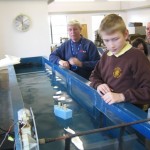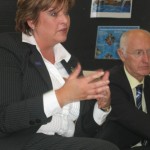

Glow Scotland blog
 A collobaration with Clydebank Museum has brought maritime history to life for children at Dalreoch Primary, writes Douglas Blane in a recent TESS article
A collobaration with Clydebank Museum has brought maritime history to life for children at Dalreoch Primary, writes Douglas Blane in a recent TESS article
You can also find out more in the Testing the Waters: Schools and museums working together Glow Cookbook
MoreToday the audience was packed into the seminar room at SLF 2011 with no sign of people losing interest on the last afternoon. They were there to see speakers Patrick Mooney, PT English at Caldervale High School in North Lanarkshire and Gilian Penny Headteacher at Gavinburn Primary School in West Dunbartonshire in the Literacy across learning: using wider texts at second and third levels seminar.
Let’s have a listen to why some of the audience were at the seminar today:
| Click on the radio to hear why an education student has come to the seminar. |  |
| Click on the radio to hear why some international visitors have come to the seminar. |  |
Patrick Mooney is PT English at Caldervale High School and previously taught English at Cardinal Newman High School. He is passionate about using moving image education as a way to enhance literacy across learning.
Let’s have a listen to Patrick describing what he will be presenting on:
| Click on the radio to hear Patrick describing what he will be speaking about in the seminar. |  |
He spoke about the challenge of teaching literacy in a modern context and widening the definition of a text. As part of becoming a chartered teacher he researched moving image education and worked with Scotland on Screen. He explained that there are often perceived constraints in the secondary sector with teacher attitude, lack of kit and the need for leadership in moving forward with moving image education in the school. Although he told us that all the kit required is a web cam and a laptop. He stressed that moving image education is an fantastic tool to ensure that active learning is happening, that the pupils are highly motivated and that it builds on their resilience.
He went on to explain that the gains that can be made in terms of inclusion, true collaboration, creativity and enterprise and opportunities for teacher reflection on their own practice are substanial. Pupils with poorer literacy skills can be released from previous ‘failures’ they may have experienced with other forms of communication. Encouragingly, Patrick talked about the possibilities that moving image education opens up in the curriculum by acting as a gel for literacy across the curriculum and inter-disciplinary learning projects. He gave ideas for outcomes/products such as science news reports; documentaries on sports personalities/famous mathematicians/historical figures; movies to analyse performance in PE and projects such as documentaries to celebrate whole school life.
Pupils can really get to employ their own creativity and choice, they can be shown simply how to use the kit and then come up with their own ideas for projects backed by a framework of teacher planning. Patrick ended by speaking about how amazed he continues to be about how much effort pupils are willng to put into these projects - the planning, storyboarding, scripting, celebrating and performing. Pupils who have been very much switched off from the writing process are happily immersed in it due to the motivation of moving image education.
Gillian Penny is Headteacher at Gavinburn Primary School in West Dunbartonshire and is passionate about the wider text and digital creativity. Her presentation alternated between short, amazing video clips of pupils from her school and her explanation of the different projects they are invloved in.
| Click on the radio to hear Gillian describing what she will be speaking about in the seminar. |  |
Gillian believes it is very important for children to have an audience and purpose for their work as this is highly motivating for them and can change the effort and pride they take in this work. She is also interested in creating opportunities for her pupils to be involved in more interdisciplinary and active learning. In the school they frequently use animation as she feels it is a very powerful tool for pupils planning and storyboarding their work. She notes that it forces them to really think about the story they are telling.
The school also uses the I Can Present tool and green screening to allow pupils to make presentations. We saw a video of children pretending to be in a band and making award acceptance speeches. Gillian notes that for teachers who need persuading about these ways of working it is hard to ignore the quantity and quality of written work from the pupils as part of their planning process when working with these kinds of tools.
The school also makes very successful use of Guitar Hero and other tools for what Gillian calls their ‘Band in a Box’ or ‘Band out of a Box’ project. Pupils are arranged into groups of 4 which are made up by the teachers in order to get an appropriate mix. They create a rock band with imaginative back stories for every member of the band. They write lyrics and put these to music and create a music video to go along with it. They also go on tour virtually to another country and have to plan all the arrangements for this down to hotels, sticking to budgets and preparing a speech in the language of the country. They have performances, including dance and awards sessions within the school. These award sessions have a red carpet where real awards are given out and important dignitries and parents come to watch.
Click here to see this video example from the Consolarium blog of one of the music videos a group of Gillian’s pupils put together:
Gillian showed a video of the pupils reflecting on the process, they are clearly very excited by and thrilled with the whole project. They are able to talk at length about all the aspects of it, how they approached these and how much of their work went into it all. Pupils get to play to their strengths, Gillian commented on the fact that perhaps the pupil who hasn’t succeeded before has a great idea for the band and the other members are able to help make this idea come to fruition.
| Click on the radio to listen to some audience reactions to the seminar. |  |
| Click on the radio to listen to some audience reactions to the seminar. |  |
So what’s next for Gavinburn? From next week Gavinburn will have their own channel on Glow TV where they will be showcasing digital work every week. This is work that is ongoing in Gavinburn but might not normally make it out of the computer.
You will catch the SLF11 Glow TV interview with Gillian Penny by clicking here where you will be asked to log in with your Glow username and password.
The Glow TV session interview with Gillian and 2 of her pupils is now available below:
In addition you might want to have a look at a video of Gillian presenting at the Games Based Learning Conference 2010:
 “The childrens learning experience was enhanced, it was a safe enviroment for them to work in. Glow meet was very succesful.”
“The childrens learning experience was enhanced, it was a safe enviroment for them to work in. Glow meet was very succesful.”
Teacher from Dalreoch Primary School in Dumbarton, West Dunbartonshire
Find out more by visiting the Glow Cookbook here
More Our first School’s Channel broadcast is coming live from Braehead Priamry School in West Dunbartonshire. Headteacher Joanne Paton contacted us through Glow and now her pupils will be taking centre stage on Glow TV for a National Event.
Our first School’s Channel broadcast is coming live from Braehead Priamry School in West Dunbartonshire. Headteacher Joanne Paton contacted us through Glow and now her pupils will be taking centre stage on Glow TV for a National Event.
Join us as the candidates for the Braehead Primary Pupil Council for 2011-2012 will be rounding off their election campaigns with their own election broadcasts outlining why they should be elected to the Pupil Council.
Watch the broadcasts and then have your own vote in school. You will be able to ask the candidates questions yourselves too! Find out the winners by logging on to the Braehead Primary website after the final vote on Tuesday 13th September.
Sign up in Glow TV and join us on Monday 12th September at 1.45pm to find out more!
MoreWest Dunbartonshire Council will demonstrate its pioneering commitment to new technology by webcasting an address from the Executive Director of Educational Services to almost three thousand staff to kick-off the new school year.
For the first time in the authority’s history every member of staff in Educational Services will be able to sit at their desks in classrooms and offices across the authority and see and hear Terry Lanagan, Executive Director, welcome them back and set out the priorities for the coming session.
The Council will be using the Glow to conduct the web conference, and will then throw open the debate to teachers and others to have an online discussion through the Glow forum tool.
Mr Lanagan intends to post a couple of key questions which will spark debate and allow everyone to contribute to shaping the key goals for the next ten months.
Terry Lanagan, Executive Director, said: “The education service in West Dunbartonshire is striving to make the very best use of new technologies for learning so that we meet the needs of 21st century pupils. They are preparing for jobs that possibly haven’t even been invented yet so we should be building on the skills they already have, and exposing them to the fantastic world of technologies for learning that are available to them.
“This address will hopefully open our staff’s eyes to the potential of Glow technology, as well as serve as a fantastic way for me to engage directly with almost 3,000 members of staff at exactly the same time. I’m also really looking forward to the planned debate that will follow as we want all staff to feel that they can share ideas right across West  Dunbartonshire and beyond.”
Dunbartonshire and beyond.”
Through Co-Create, Drake Music Scotland is working in partnership with West Dunbartonshire Council and Kilpatrick Secondary School on SHINE, a project which is shedding light on the artistic process, unpacking resources and sharing experiences and performances via Glow.
Using new Soundbeam 5 technology and the Figurenotes notation system, pupils are taking part in creative music making sessions which are designed to be fully accessible for Kilpatrick School’s pupils with Additional Support Needs.
Drake Associate Musician Matilda Brown is visiting the school every Wednesday to make music more accessible across the school. Pupils are learning new skills and creating their own compositions and teachers are being trained in using the music technology. Throughout this academic year, pupils and staff will be sharing their learning through Glow.
During the project, the Glow Group will be developed by project participants, and it will then be opened up nationally so that teachers across Scotland can see what can be achieved with resources such as Soundbeam 5 and Figurenotes. Drake will highlight best practice in the creative use of this valuable technology and enable discussions to take place to develop this on a national level.
The SHINE project supports the Experiences and Outcomes for the Expressive Arts, (Music) Literacy and Numeracy and Health and Wellbeing across the curriculum. It also upholds the progression principles of the Curriculum for Excellence, in particular, challenge and enjoyment, relevance and coherence.
Co-Create is funded through a partnership between Learning and Teaching Scotland and the Creative Scotland National Lottery Fund.
Image credit: Colin Dickson
More The SLF Extra Glow Group is now live, with things to see before the Scottish Learning Festival, and a preview of what to expect over the two days. One event you can get involved in before the festival is a Glow Meet Session with Fiona Hyslop, the Cabinet Secretary for Education and Lifelong Learning. In advance of her Keynote Speech at SLF, Ms Hyslop will be hosting a Glow Meet for Scottish Schools from Gavinburn Primary School in West Dunbartonshire. The Glow Meet will take place on the 15th of September between 1pm and 2pm.
The SLF Extra Glow Group is now live, with things to see before the Scottish Learning Festival, and a preview of what to expect over the two days. One event you can get involved in before the festival is a Glow Meet Session with Fiona Hyslop, the Cabinet Secretary for Education and Lifelong Learning. In advance of her Keynote Speech at SLF, Ms Hyslop will be hosting a Glow Meet for Scottish Schools from Gavinburn Primary School in West Dunbartonshire. The Glow Meet will take place on the 15th of September between 1pm and 2pm.
The cabinet secretary will be talking about what it means to her to be Scottish, and inviting questions from the children at Gavinburn and the Glow audience.
To sign up your class to watch or to take part in the question and answer session, please visit the SLF Extra Glow Group by clicking on this link
More This is a guest post from Rhona Mackenzie of West Dunbartonshire Council - Cross Posted from the National CPD Team Blog
This is a guest post from Rhona Mackenzie of West Dunbartonshire Council - Cross Posted from the National CPD Team Blog
West Dunbartonshire has had an involvement in the Microsoft Innovative Teacher initiative since 2006.
Initially this project was concerned with fostering a community of practice which involved all our Glow mentors but a year ago the focus was moved, by Microsoft, to peer coaching. This involved a week long facilitators’ course near London which I attended in November 2008. As the week progressed, it became obvious that this was a methodology which would fit well with the Glow rollout in our authority.
The rollout of Glow within West Dunbarton had stalled for over a year due to technical problems with our firewalls. While we had made a gentle start in our rollout in the summer term of 2009, we were looking for a way to jump start the process at the start of the new academic session. The peer coaching strategy seemed to fit the bill and we sent out an invitation to all our education staff to take part. It was decided that the only viable way of running the course was to offer two days during term time with paid cover: one in the summer term of 2008/9 and one in the autumn term of 2009/10. The rest of the course would take place over four days during the summer holidays. Two identical four day courses were held, one during the second week of the holidays and the other during the second last week of the holidays. All the staff met for the initial day at the end of June and will come together again in the autumn term. The first course in July had 12 staff attending whilst the August course had 8. Both courses had a mix of Glow mentors and enthusiastic practitioners.
Because the main part of the course took place during the summer holidays, there was a very relaxed atmosphere. No one was worried about what was happening in their classroom while they were attending the course and the fact that everyone felt they were in their “own time” added to the lack of pressure. Each day started with an icebreaker activity which helped set the stress-free atmosphere for the rest of the day.
All staff were asked to bring an idea for a lesson which they could use in the new school session. The plan for this lesson became the basis for the peer coaching protocols and also for the creation of a Glow group designed to enhance the lesson. The pattern for each day consisted of an icebreaker activity, a Glow activity, such as resizing images for Glow, Glow Chat, Glow Meet, Glow Learn (taster session only) and a number of peer coaching protocols and other strategies. As well as the new experiences and outcomes from the Curriculum for Excellence we also looked at other initiatives such as “Beyond Engagement” from Becta and spent some time in discussion over these. This gave staff a chance to explore Glow and current pedagogical thinking in a meaningful way, to interact with and learn from each other and to investigate practices which impact on using Glow effectively. We also had a session looking at freeware such as Xmind and AutoCollage among others.
Towards the end of the course, all participants were asked to create a coaching plan showing how they planned to take the peer coaching approach to Glow forward in their own establishments. It became obvious very quickly that the SMT in the school would have to buy into this method of introducing Glow.
The feedback at the end of the two four day courses was that everyone was leaving with a clear understanding of how Glow could enhance the learning and teaching in their class, a greater knowledge of other establishments and sectors within the authority as well as some new found friends.
We now have a dynamic peer coaching Glow group at authority level which will be our main method of communication and collaboration. We do, however, have two dates in our diaries for face to face meeting. The first will be a twilight in September just to get together and discuss how everyone is using Glow within their own practice. We will also be examining roadblocks and reminding ourselves of strategies to overcome them. The second day will be towards the end of November when we will have a full day examining the impact that the peer coaching is having on each establishment.
The evaluations from each of the two four day courses show that the course was greatly enjoyed by all who attended it. The proof of the success of the course, however, will be the uptake of Glow in the peer coaches’ establishments. Microsoft is having the peer coaching programme independently evaluated and West Dunbarton is one of only three local authorities that are taking part in this evaluation.
MoreA two-day training session for Glow Mentors in West Dunbartonshire in early February covered the essentials of using Glow components. The group began by creating their own curricular Glow Groups and then adding tools which would allow the groups to fulfil their purpose.
But besides working on the ‘how to’, the training also addressed the ‘why?’ of using Glow. Discussions focused on Glow in the classroom, linking its use to Curriculum for Excellence. On the second day of training the Glow team looked at the curricular Glow Groups that the mentors had created the day before, discussing how these would tie in with the Curriculum for Excellence ethos.
The role of the Glow Mentor was also considered: a series of workshops was delivered by the Glow team to help mentors appreciate the importance of their role and to focus on the skills they already possess, which will help them take Glow out into the wider authority.
West Dunbartonshire is now ready to get Glowing.
Read more about Glow in West Dunbartonshire.
More
Find us on